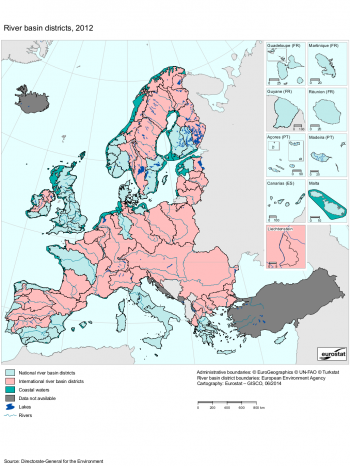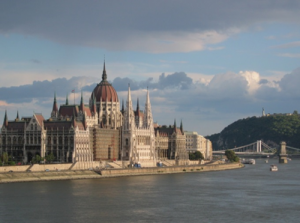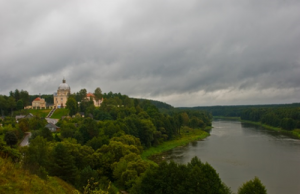Archive:Environmental statistics at regional level
- Data from March 2014. Most recent data: Further Eurostat information, Main tables and Database.
Maps can be explored interactively using the Eurostat Statistical Atlas (see User's manual).
This article is part of a set of statistical articles based on the Eurostat Regional Yearbook publication. It presents a selection of Eurostat’s regional environment statistics, focusing on water and municipal waste statistics.
Water is a limited resource that is essential for life and economic activities. In many areas the European Union’s (EU’s) water policy has contributed to significant improvements in water quality over the past 30 years, whether relating to coastal waters, rivers and lakes or to the safety of tap water.
Concerning waste management, the EU’s approach is based on three principles: waste prevention, recycling and reuse; final disposal and monitoring should be improved as well.
Human well-being — especially for future generations — is linked to the sustainable use of natural resources and the maintenance of ecosystems. Sustainable development strategies are based on ensuring that economic growth and a better quality of life go hand in hand with environmental protection.
Main statistical findings
Water
Water resources in the EU, in the form of rivers and lakes (including reservoirs) on the one hand, and groundwater on the other, are used for many essential purposes such as public water supply (hygiene, cleaning, nutrition etc.), cooling in energy production, transportation (inland waterways), and irrigation (watering crops). Water is also the basic constituent of aquatic ecosystems which filter and dilute pollution, contribute to preventing floods, maintain the microclimatic balance and safeguard biodiversity.
The health of Europe’s water bodies (any discrete and significant element of water, such as rivers, lakes, seas, wetlands, reservoirs and groundwater) is influenced by the characteristics of each catchment area: for example, climatic conditions, bedrock geology and soil types influence the flow, chemistry and biology of water. Human activities also affect water bodies: while, for example, afforestation helps to protect water resources, urbanisation or the discharge of wastewater are typical anthropogenic pressures.
According to the European Environment Agency (EEA), there have been significant advances over the last 20 years in the treatment of sewage and industrial wastes that are pumped into the EU’s river systems. This has led to lower levels of pollutants and a measurable improvement in the quality of the EU’s waterways. Nevertheless, nitrate levels remain high: this is mainly caused by intensive farming activities entailing a discharge of surplus fertiliser into water bodies.
River basin districts
A river basin district is defined in the EU’s Water Framework Directive (2000/60/EC) as an ‘area of land and sea, made up of one or more neighbouring river basins together with their associated groundwater and coastal waters …’; in other words, ‘… it is the area of land from which all surface run-off flows through a sequence of streams, rivers (and possibly lakes) into the sea’.
There are 128 river basin districts designated in the EU, of which 49 are international. Water management by river basin district is one of the core aspects of the EU’s water policy, based on an all-inclusive catchment area approach from source to sea (including both surface waters and groundwater), rather than on administrative boundaries. Map 1 shows the principal river basin districts in the EU: it also provides a division between international and national river basins (note that Maps 1–3 in this article do not use the NUTS classification).
Danube, Vistula and Rhine river basins drain just over a quarter of the EU’s territory
Although there are numerous river catchment areas in Europe, they are small (by global standards). The three largest EU river basins are the Danube (817 000 km²), the Vistula (194 000 km²) and the Rhine (170 000 km²), which together drain over one quarter of the EU-28’s territory. The Danube is 2 860 km long and the largest river to discharge into the Black Sea: it flows through Germany, Austria, Slovakia, Hungary, Croatia, Serbia, Bulgaria and Romania. Its drainage basin also covers parts of Switzerland, Italy, the Czech Republic, Poland, Slovenia, Ukraine, Moldova, Bosnia and Herzegovina, the former Yugoslav Republic of Macedonia, Montenegro and Albania. The Vistula is 1 047 km long and one of the main rivers discharging into the Baltic Sea (others include the Oder and the Nemunas); it flows exclusively within Poland, although its drainage basin also covers parts of Belarus, Ukraine and Slovakia. The Rhine is 1 233 km long and flows through Switzerland, Liechtenstein, Austria, Germany, France and the Netherlands to run into the North Sea (along with the Elbe, the Loire and the Douro it is one of the largest river basin districts flowing into the Atlantic and North Sea); its drainage basin also covers parts of Italy, Luxembourg and Belgium. The main river basin districts that flow into the Mediterranean include the Rhône, the Ebro and the Po.
Each river basin district can be divided into smaller, national subunits. For example, as the Rhine passes through Germany, nine separate subunits are defined — in other words, smaller catchment areas that form part of or ultimately flow into the Rhine, namely: Lake Constance/Alpine Rhine, Hochrhein, Oberrhein, Neckar, Main, Moselle-Saar, Middle Rhine, Lower Rhine and the Rhine delta.
Water abstraction by river basin districts
Water abstraction is the removal of water, permanently or temporarily, from rivers, lakes, canals, reservoirs or from underground strata. Water resources need to be managed carefully to ensure that people have access to affordable and safe drinking water and sanitation, while at the same time safeguarding that abstraction levels are environmentally sustainable. For example, the rapid expansion in groundwater abstraction across parts of Europe during the last 40 years in regions where surface water resources are insufficient has the potential to lead to a lowering of the water table, or a loss of wetland habitats. As such, water authorities across the EU seek to control how much water is abstracted, where and when (seasonal fluctuations). While water abstraction can be a major pressure on water resources, a large part of the water used to supply domestic, industrial or agricultural uses is returned to water bodies (although sometimes as wastewater with impaired quality).

(million cubic metres) - Source: Eurostat (env_watabs_rb)
The overall abstraction and use of water resources can be considered to be sustainable in the long-term in most of Europe. However, specific regions may face problems associated with water scarcity; this is especially the case in parts of southern Europe, where it is likely that efficiency gains, for example in relation to agricultural water use, will need to be achieved in order to prevent seasonal water shortages. Regions associated with low rainfall, high population density, or intensive industrial activity may also face sustainability issues in the coming years.
Approximately one fifth of the total freshwater abstracted in Europe supplies public water systems — water that is directed to households, small businesses, hotels, offices, hospitals, schools and some industries. There are considerable differences in the volumes of water that are abstracted across the EU: these reflect the resources available, climate, local abstraction practices, and the economic make-up of each area. Map 2 shows the volume of groundwater abstraction for public water supply, by river basin, it can be contrasted with the information presented in Map 3 which shows similar information on the volume of surface water abstraction.
The highest level of groundwater abstracted for public water supply was for the Po river basin district (northern Italy)
Among the river basins for which data are available, the highest volume of groundwater abstracted for public water supply occurred in Italy. The Po river basin — which runs from west to east across the north of Italy — had by far the largest volume of groundwater abstracted for public water supply, some 2.26 billion m³ in 2008. Aside from providing public water supply to major cities such as Torino and Milano, water from the Po river basin district is also used for power generation (and cooling), industrial applications and agriculture in one of the most densely populated and economically developed regions of Italy.
Groundwater abstraction also relatively high for other Italian river basin districts
The Southern Apennines, Middle Apennines and Eastern Alps — all in Italy — were the only other river basin districts in the EU with groundwater abstraction levels of at least one billion m³. These relatively high figures reflect, to some degree, the geological characteristics of the Italian territory, which often favours the storage of groundwater in aquifers.
Aside from the four Italian river basin districts mentioned above there were 15 additional river basins in the EU where at least 200.0 million m³ of groundwater was abstracted for public water supply (generally in 2010); these are shown by the darkest shade in Map 2. They were concentrated in western Europe — often subunits of the Rhine river basin district — but also included the Seine and Garonne. Five of these 15 river basin districts were from each of Germany and France, two from the Netherlands and two additional river basin districts from Italy, while there was a single district from Bulgaria.

(million cubic metres) - Source: Eurostat (env_watabs_rb)
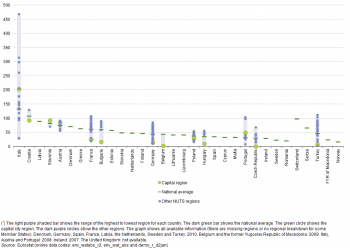
(cubic metres per inhabitant) - Source: Eurostat (env_watabs_r2), (env_wat_abs) and (demo_r_d2jan)
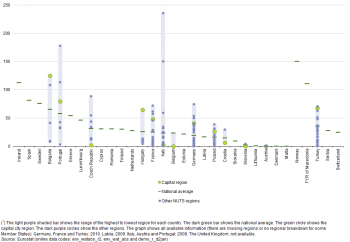
(cubic metres per inhabitant) - Source: Eurostat (env_watabs_r2), (env_wat_abs) and (demo_r_d2jan)
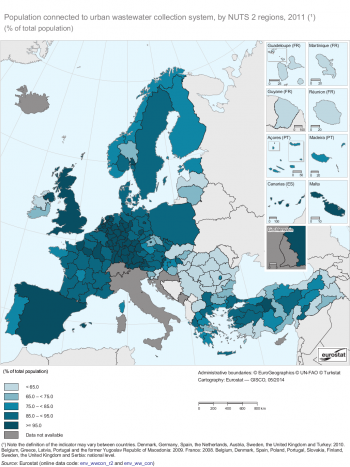
(% of total population) - Source: Eurostat (env_wwcon_r2) and (env_ww_con)
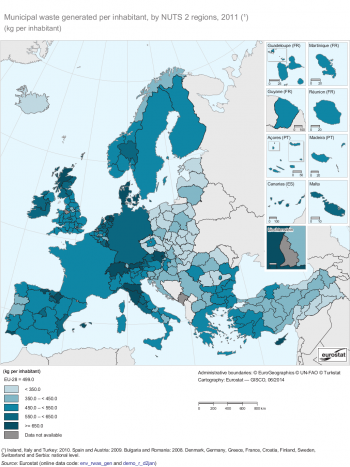
(kg per inhabitant) - Source: Eurostat (env_rwas_gen) and (demo_r_d2jan)
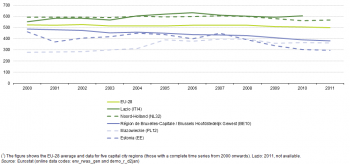
(kg per inhabitant) - Source: Eurostat (env_rwas_gen) and (demo_r_d2jan)
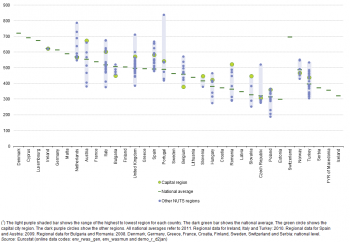
(kg per inhabitant) - Source: Eurostat (env_rwas_gen), (env_wasmun) and (demo_r_d2jan)
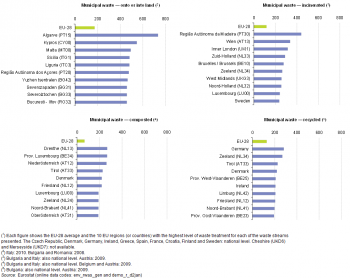
(kg per inhabitant) - Source: Eurostat (env_rwas_gen) and (demo_r_d2jan)
Map 3 shows that the volume of surface water abstracted for public water supply was often lower than the corresponding level of groundwater abstraction. For example, in the Po river basin district, surface water abstraction was relatively high — 229.7 million m³ for public water supply in 2008, the 11th highest volume in the EU — but was approximately one tenth the volume of groundwater abstraction.
The Lower Rhine (Germany) had the highest level of surface water abstraction for public water supply
Across the available basins for which data are available, the highest volume of surface water abstracted for public water supply was recorded for the German river basin district of the Lower Rhine, at 624.7 million m³ in 2010. It was one of 26 river basin districts across the EU to record a level of abstraction of at least 100.0 million m³; these river basins are shown as the darkest shade in Map 3. The 26 river basin districts with the highest levels of surface water abstraction for public water supply were spread across 12 different EU Member States, although — in keeping with the concentration of groundwater abstraction — a majority were located in France, Germany and Italy.
Water abstraction by NUTS regions
Figures 1 and 2 show information relating to groundwater and surface water abstraction for public water supply, based on NUTS 2 regions rather than river basins. Groundwater abstraction for public water supply per inhabitant was very high for a number of Italian regions. Indeed, there were no regions from any of the other EU Member States where groundwater abstraction per inhabitant was higher than the average for all Italian regions.
Groundwater abstraction per inhabitant highest in the southern Italian region of Molise …
Between Italian regions there was a considerable range as regards the level of groundwater abstracted per inhabitant (see Figure 1). The highest levels of groundwater abstraction were recorded in populous NUTS 2 regions such as Lombardia, Lazio, Campania and Veneto. However, the peaks of abstraction per inhabitant were registered in the southern regions of Molise, Basilicata and Abruzzo, and the northern regions of Valle d'Aosta/Vallée d'Aoste and Provincia Autonoma di Trento. An average of 468.4 m³ of groundwater for public water supply was abstracted for each inhabitant in Molise in 2008.
Outside of Italian regions, the highest level of groundwater abstraction per inhabitant was recorded for the Croatian region of Jadranska Hrvatska (129.1 m³). Bourgogne and Languedoc-Roussillon (both France) and the Portuguese Região Autónoma dos Açores were the only other NUTS 2 regions (subject to data availability) where the level of groundwater abstraction for public water supply was above 100.0 m³ per inhabitant; this level was also exceeded in two eastern Turkish regions, namely, Agri, Kars, Igdir, Ardahan and Van, Mus, Bitlis, Hakkari.
… while surface water abstraction was highest in the southern Italian region of Basilicata
Figure 2 shows surface water abstraction for public water supply analysed for NUTS 2 regions. The highest levels of abstraction per inhabitant were recorded in the Italian regions of Basilicata (236.1 m³) and Sardegna (150.2 m³), and in the Portuguese region of the Algarve (178.0 m³). The Bulgarian regions of Yugozapaden and Yugoiztochen — the former being the capital region — and the Portuguese region of the Região Autónoma da Madeira were the only other NUTS 2 regions (subject to data availability) where the level of surface water abstraction for public water supply was above 100.0 m³ per inhabitant. While for groundwater abstraction the capital region often recorded a lower level of abstraction than the national average, the opposite was generally the case for surface water abstraction; this was particularly true in Bulgaria and Hungary.
Urban wastewater
The pollution of rivers, lakes and groundwater is affected by human activities as is water quality in general. In efforts to reduce the level and range of pollutants discharged into the environment through wastewater, the EU has implemented legislation on urban wastewater treatment (Directive 1991/271/EC). Map 4 presents information in relation to the proportion of the population that is served by an urban wastewater collection system (sewer systems regardless of the availability of treatment facilities (primary to tertiary treatment) and transport by wastewater trucks).
The entire population of Praha and Malta was connected to an urban wastewater collection system
It is not surprising to find that the highest connection rates to urban wastewater collection systems were recorded in densely populated regions, and in particular, capital regions. Generally, there was an east–west split of connection rates, with the highest rates generally recorded in western European regions. Nevertheless, the whole of the population (100.0 %) of the Czech capital region of Praha was connected to an urban wastewater collection system in 2011, as was the population of Malta (which is a single region at this level of analysis). There were 52 other regions (subject to data availability) where at least 95.0 % of the population was connected to an urban wastewater collection system, as shown by the darkest shade in Map 4. Many of these regions were concentrated in Germany and the Netherlands (data are for 2010 for both of these Member States), while Spain (data are only available at the national level and for 2010) and Luxembourg (a single region at this level of analysis) also recorded rates of at least 95.0 %. Connection rates were also quite high across most regions in France (data are for 2008) and Austria (data are for 2010).
There were 19 NUTS 2 regions where the proportion of the population that was served by an urban wastewater collection system was lower than 65.0 % — as shown by the lightest shade in Map 4. Among these, there were 12 regions where less than half of the population was connected, including: Latvia (a single region at this level of analysis, data are for 2009); the Irish region of Border, Midland and Western; six out of the eight NUTS 2 regions from Romania; and the four French overseas regions (data are for 2008). Note that some of the Member States that joined the EU in 2004 or later have transitional periods to comply with the specifications for implementing the Urban Wastewater Treatment Directive and that low connection rates in some parts of eastern Europe are expected to rise in the coming years, as investment in new plant comes on-stream.
Municipal waste
Municipal waste consists to a large extent of waste generated by households, but may also include similar wastes generated by small businesses and public institutions that are collected by municipalities; it excludes waste from sewage treatment, construction and demolition activities.
The overall amount of municipal waste generated in a country is related to the degree of urbanisation, patterns of consumption, household revenue and lifestyles. Increasing affluence is generally associated with rising consumption, which tends to result in higher amounts of municipal waste being generated, a higher proportion of which is composed of plastics and metals. The amount of municipal waste generated per inhabitant provides a measure of the potential environmental and health pressures, for example, from soil and water contamination or poor air quality.
Each inhabitant in the Algarve generated an average of 838.4 kg of municipal waste …
On average, each inhabitant in the EU-28 generated 499.0 kg of municipal waste in 2011. There were 17 regions where this ratio rose to at least 650.0 kg per inhabitant, as shown by the darkest shade in Map 5. The highest amount of municipal waste generated was in the Algarve (Portugal) — averaging 838.4 kg per inhabitant in 2011; note that this region has a high number of tourists and these temporary visitors may inflate the average amount of waste generated per inhabitant. The next highest level of municipal waste generated per inhabitant among Portuguese regions was recorded in the capital region of Lisboa (542.0 kg). The 16 remaining regions where the level of municipal waste generated was at least 650.0 kg per inhabitant included four regions from the Netherlands, three regions from each of Spain and Austria, two regions from Italy, as well as a single region from the United Kingdom; it also included Denmark (only national data available), Luxembourg and Cyprus (both single regions at this level of analysis).
… which was almost 4.5 times as much as in the Polish region of Świętokrzyskie
There was a relatively low intensity of waste generation in 30 regions across the EU — as shown by the lightest shade in Map 5. They were exclusively located in eastern Europe and the Baltic Member States, covering regions from the Czech Republic, Hungary, Poland, Romania and Slovakia, as well as Estonia and Latvia (both single regions at this level of analysis). The south-eastern Polish region of Świętokrzyskie recorded the lowest level of municipal waste, averaging 188.6 kg per inhabitant in 2011; it was the only NUTS 2 region within the EU to report less than 200.0 kg of municipal waste per inhabitant.
Figure 3 shows the development of the amount of municipal waste generated per inhabitant for the EU-28 average and for five capital regions (selected on the basis of those regions that had a lengthy time series). It shows that the average amount of waste generated per inhabitant in the EU-28 fell by 24 kg between 2000 and 2011. The vast majority of this reduction took place at the end of the period under consideration, as the average volume of municipal waste generated in the EU-28 was 520 kg per inhabitant in 2008. As such, the sizeable reduction in 2009, followed by smaller reductions in 2010 and 2011, are likely to reflect, at least in part, lower levels of consumption as a result of the financial and economic crisis. Among the five capital regions shown in Figure 3, the biggest reduction in municipal waste per inhabitant over the period 2000–11 was recorded for Estonia (a single region at this level of analysis). By contrast, there were increases in the levels of waste generated per inhabitant in the Italian and Polish capital regions.
The level of municipal waste treatment per inhabitant was higher in most capital regions than for the national average across most of the EU Member States for which data are available, as shown in Figure 4. This may be linked to the average size of households, with the proportion of people living in one person households being relatively high in capital cities (one person households generally consume more products and packaging per inhabitant than households that are occupied by larger numbers of people). The capital regions of Wien, Bucureşti – Ilfov, Zahodna Slovenija and Bratislavský kraj recorded the highest levels of municipal waste treated per inhabitant among any of the regions from Austria, Romania, Slovenia and Slovakia respectively. By contrast, the Région de Bruxelles-Capitale / Brussels Hoofdstedelijk Gewest and Yugozapaden recorded the lowest levels of municipal waste treatment among any of the regions in Belgium and Bulgaria, while the waste treated per inhabitant in the Czech and Dutch capital regions was slightly less than their respective national averages. It should be noted that waste is not always treated in the same region as where it was generated.
The amount and composition of municipal waste for final disposal by type of treatment depends on national waste management practices. The EU is committed to reducing the amount of waste that is sent to landfill, while raising the proportion of waste that is recycled or composted. Figure 5 shows the amount of waste for four different waste streams: it presents information for the EU-28 average and the 10 regions with the largest volume of waste treated for each of the four waste streams; note that these rankings are presented subject to data availability.
The Algarve and several island regions tended to favour landfill for the treatment of their municipal waste …
The highest amounts of waste deposited onto or into land were consistently recorded in southern and eastern regions. An average of 736.1 kg of waste per inhabitant was treated in this manner in the Algarve in 2011; this was 4.2 times as high as the EU-28 average. Landfilling was also a common form of waste treatment in the islands of Cyprus, Malta, Sicilia (Italy) and the Região Autónoma dos Açores (Portugal).
… while incineration was relatively popular in densely populated regions
A high volume of municipal waste was incinerated on the other autonomous Portuguese islands, the Região Autónoma da Madeira, some 441.7 kg per inhabitant in 2011; this was 3.7 times as high as the EU-28 average. The other regions where relatively high volumes of waste were incinerated were often densely populated regions, where the relatively high price of land may make it prohibitive for municipalities to establish landfill sites; these included the capital regions of Wien, Inner London and Bruxelles / Brussels.
Belgium, Germany, the Netherlands and Austria relatively specialised in composting and recycling
In Belgium, Germany, the Netherlands and Austria composting and recycling accounted for the majority of the municipal waste treated. This is reflected in the regions that appear in the final two parts of Figure 5. The Dutch region of Drenthe composted 268.6 kg of municipal waste per inhabitant in 2011 (which was four times as high as the EU-28 average); it was one of four Dutch regions that featured in the listing of the 10 EU regions with the highest levels of composting. An average of 283.0 kg of municipal waste per inhabitant was recycled in Germany (only national data available); this was 2.2 times as high as the EU-28 average.
Data sources and availability
Regional environment questionnaires
Regional environment statistics can be used in the development, implementation, monitoring and evaluation of EU environmental policy, in particular, environment action programmes. This is done by the European Commission’s Directorate-General for the Environment in partnership with the European Environment Agency (EEA). The data presented in this article have been restricted to information concerning regional water and municipal waste statistics, where availability is generally quite good.
The data presented were collected through a regional environmental questionnaire, coordinated by Eurostat. This data collection exercise was initiated upon the request of the European Commission’s Directorate-General for Regional and Urban Policy.
An initial pilot study was conducted in 2010, and this was followed by a more extensive regional environmental questionnaire in the second half of 2012. Replies to this were received from 24 EU Member States, two EFTA and three candidate countries; there are considerable differences in the availability of statistics between countries and across the various topics for which information was collected.
The regional environmental questionnaire treats two types of subnational statistics. On the one hand, data are collected with a regional breakdown, generally provided at the NUTS 2 level (although some EU Member States provided data at the NUTS 1 level). On the other, selected water statistics are collected according to a classification of river basin districts and their accompanying subunits, based on hydrological areas as defined in the EU’s Water Framework Directive.
Replies to the questionnaire were provided on the basis of a gentlemen’s agreement. Coverage by environmental domain varies considerably and the information presented in this article has been selected as a function of the availability per domain. At the NUTS 2 level, data are available for: 73 % of regions for water and 87 % for municipal waste. Among those domains that are not covered in this article, data coverage by region was as follows: 52 % for environmental expenditure; 14 % for transport-related indicators; 30 % for energy-related indicators; and 47 % for land use. The coverage of water statistics collected by river basin districts and accompanying subunits was 67 %.
It should be noted that the harmonisation of concepts and definitions for regional environmental statistics is still under development and caution is therefore urged if comparing regional data between countries and when making comparisons of regional data for a particular country with national totals/averages for the same country (definitions for the latter may vary, especially when national data collections have a legal basis).
Indicator definitions
Water
River basin districts and their subunits are delineated by EU Member States under the Water Framework Directive; they are used for the management of river basins. Some river basins span more than one country (for example, the Danube) and these are known as international river basin districts; those contained within a single country are national river basin districts. River basin districts are defined as the area of land and sea, made up of one or more neighbouring river basins together with their associated ground waters and coastal waters. Coastal waters are defined as one nautical mile from the coastline and extending, where appropriate, up to the outer limit of transitional waters. Transitional waters are defined as bodies of surface water in the vicinity of river mouths which are partly saline in character as a result of their proximity to coastal waters but which are substantially influenced by freshwater flows.
Water abstraction is the process of taking water from a source; for statistical purposes in the EU, it is defined as the sum of groundwater and surface water that is collected for use. Groundwater is fresh water found beneath the earth’s surface, specifically in cracks and spaces in soil, sand and rock. Fresh surface water flows over, or rests on the surface of a land mass, in the form of natural waterways (rivers, streams, brooks and lakes) or artificial waterways (irrigation, industrial and navigation canals, drainage systems and artificial reservoirs).
Wastewater is water that is of no further immediate value to the purpose for which it was used or in the pursuit of which it was produced because of its quality, quantity or time of occurrence. Wastewater from one user can be a potential supply of water to another user elsewhere.
Waste
Waste may be defined as any substance or object which the holder discards or intends or is required to discard. Municipal waste consists of waste collected by, or on behalf of, municipal authorities and disposed of through waste management systems. Municipal waste consists mainly of waste generated by households, although it also includes similar waste from sources such as shops, offices and public institutions. In those EU Member States with complete (national) coverage, the total volume of municipal waste generated is equal to total volume of municipal waste collected. For those countries where waste collection schemes do not cover their whole territory, estimates are made for the waste generated in areas that are not covered.
The treatment of municipal waste may be classified as: landfill, incineration, recycling or composting. Landfill is the deposit of waste into or onto land; it includes specifically engineered landfill sites and temporary storage of over one year. Incineration is a method of waste disposal that involves the combustion of waste; incineration with energy recovery refers to incineration processes where the energy created in the combustion process is harnessed for re-use, for example for power generation. Waste recycling is defined as any recovery operation by which waste materials are reprocessed into products, materials or substances whether for the original or other purposes; it includes the reprocessing of organic material but does not include energy recovery. Composting is defined as a biological process that submits biodegradable waste to anaerobic or aerobic decomposition and that results in a product that may be used on land or as part of the manufacturing process for producing enriched growing mediums.
Context
In recent decades the EU has put in place a broad range of environmental legislation, which has contributed to various forms of air, water and soil pollution being significantly reduced. At the same time, the EU seeks to protect natural habitats, with almost one fifth of the EU’s territory designated as protected areas for nature.
The Water Framework Directive and a blueprint to safeguard European water resources
Introduced in 2000, the Water Framework Directive (2000/60/EC) takes an integrated approach to water policy developed around protecting ecosystems from pollution, over-abstraction and structural changes. It is based on the premise that the best model for water management is a system that focuses on the management of river basins — a natural geographical and hydrological unit. EU Member States are encouraged to identify their river basins and to propose management plans for protecting all of their water bodies (including surface waters and groundwater). An important step in the implementation of this legislation involved the European Commission adopting an assessment of the implementation of the river basin management plans (COM(2012) 670 final).A blueprint to safeguard European water resources (COM(2012) 673 final) was adopted in November 2012. It provides a strategy to reinforce water management in the EU, integrating the results of a review of the EU’s water policy framework and a policy review concerning: the implementation of river basin management programmes; issues related to water scarcity and droughts; a review of the vulnerability of environmental resources to climate change impacts and man-made pressures. It aims to ensure that good quality water is available across Europe in sufficient quantities for all legitimate uses. It focuses on changes required to the EU’s water policy framework up to 2020, and is closely related to the Europe 2020 strategy.
For more information: Water Framework Directive; A blueprint to safeguard European water resources
Seventh Environment Action Programme
Environment action programmes have guided the development of EU environment policy since the early 1970s: this has helped raise awareness of environmental issues and resulted in significant achievements being made during the last 40 years across a wide range of environmental areas.
The seventh Environment Action Programme (7th EAP) to 2020 — ‘Living well, within the limits of our planet’ (Decision No 1386/2013/EU) was adopted by the Council and European Parliament on 20 November 2013; it provides a vision for EU environment policy through to 2020 and beyond. It aims to: encourage more resource-efficiency; accelerate the transition to a low-carbon economy; stimulate sustainable growth; and create ‘green jobs’ — all of which are designed to ensure that the EU becomes a better and healthier place to live.
The 7th EAP has nine priority objectives. The first three of these are thematic in nature: protect nature and strengthen ecological resilience; boost sustainable resource-efficient low-carbon growth; effectively address environment-related threats to health. The following four objectives focus on the tools for enabling the programme: promote better implementation of EU environment law; ensure that policies benefit from cutting-edge science; secure the necessary investments in support of environment and climate change policy; improve the way environmental concerns and requirements are reflected in other policies. The final two objectives concern the spatial dimension: enhance the sustainability of the EU’s cities; improve the effectiveness of the EU in addressing regional and global challenges.
Europe 2020
The EU is seeking to change its patterns of both consumption and production. Indeed, sustainable growth is one of the three main pillars of the Europe 2020 growth strategy to become a ‘smart, sustainable and inclusive economy’. The creation of a sustainable economy is focused on moving towards a low-carbon economy, and one of the five key headline targets for Europe 2020 covers climate change and energy sustainability, where the EU seeks: to lower its greenhouse gas emissions by 20 % (or even 30 % if the conditions are right) compared with 1990; to generate 20 % of its energy from renewable sources; and to increase energy efficiency by 20 %.
The environment may have the potential to be a major source of economic growth, by encouraging innovative clean technologies, fostering efficient energy use, building up eco-tourism, or enhancing the attractiveness of natural areas by protecting habitats and biodiversity. In January 2011, the European Commission set out a role for regional policy in contributing to the implementation of the Europe 2020 strategy (COM(2011) 17 final), in particular the flagship initiative of a ‘Resource-efficient Europe’ (see box for more details). The proposals sought to encourage greater focus for investments in a resource-efficient and low-carbon economy, while improving policy delivery mechanisms. To contribute to the sustainable growth objectives and targets of Europe 2020, three priorities were identified: a low-carbon economy, ecosystem services and biodiversity, and eco-innovation.
A resource-efficient Europe — a flagship Europe 2020 initiative
In 2011, the European Commission adopted a communication launching a flagship initiative titled ‘A resource-efficient Europe’ (COM(2011) 21); this supports the shift towards a resource-efficient, low-carbon economy as a means for achieving sustainable growth.Natural resources underpin economic developments and the quality of life enjoyed across Europe. If current consumption patterns continue, then many resources will become depleted or exhausted. As such, increasing resource efficiency is seen as a key initiative for maintaining resources, securing growth and jobs through new economic opportunities that have the potential to lead to productivity gains, lower costs and increased competitiveness.
The flagship initiative for a resource-efficient Europe provides a long-term framework for actions in many policy areas, supporting policy agendas for climate change, energy, transport, industry, raw materials, agriculture, fisheries, biodiversity and regional development.
For more information: A resource-efficient Europe — a Europe 2020 initiative
In May 2012, the European Commission proposed a European innovation partnership (EIP) on water; this was endorsed by the Council the following month. The objective of the EIP on water is to support and facilitate the development of innovative solutions to deal with the many water-related challenges, as well as to support economic growth by bringing such solutions to the market.
Environment — cohesion policy funding
The EU promotes sustainable development whereby economic, social and environmental objectives are integrated. It requires EU Member States to carry out environmental impact assessments when they seek financial support from cohesion policy programmes in areas such as environmentally-friendly technologies, sustainable transport, energy and infrastructure initiatives, as well as measures targeted at the protection of water, air, biodiversity and nature protection. As such, cohesion policy can play an important role in supporting efforts to adapt to future climate change and minimise its negative impacts at a regional level, supporting both adaptation measures for new infrastructure or retro-fitting existing infrastructure.During the period 2007–13 the EU allocated a total of EUR 104.4 billion to environment-related projects, equivalent to 30.3 % of its total cohesion budget; the majority of this funding was provided under the convergence objective. Almost half of this total was allocated to direct investments (14.5 %), for example, those related to the management of household and industrial waste, the management and distribution of drinking water, (waste) water treatment, air quality, pollution controls, the rehabilitation of industrial sites or the promotion of biodiversity. The other half was provided for indirect investments which have a considerable environmental impact (for example, transport or energy-related projects). Clean transport initiatives — covering all modes of transport — accounted for 8.8 % of the total cohesion policy budget during 2007–13, while other indirect investments accounted for 7.0 % of the total; this latter heading includes assistance to SMEs, renewable energy initiatives and energy efficiency, co-generation and energy management initiatives.
For more information: Cohesion policy and the environment
See also
Further Eurostat information
Data visualisation
Publications
- Energy, transport and environment indicators pocketbook, 2013 edition
- Environmental Statistics and Accounts in Europe, Eurostat 2010
- Generation and treatment of municipal waste (SiF 31/2011)
Main tables
- Waste (t_env), see:
- Waste statistics (t_env_was)
- Water (t_env), see:
- Water (t_env_wat)
Database
- Waste statistics (env_was)
- Waste generation and treatment (env_wasgt)
- Water (env_wat)
Dedicated section
Methodology / Metadata
- Waste generation and treatment (ESMS metadata file — env_wasgt_esms)
- Water statistics on national level (ESMS metadata file — env_nwat_esms)
Source data for tables, figures and maps (MS Excel)
Other information
- Communication 'A blueprint to safeguard Europe's water resources' (COM(2012) 673 final)
- Directive 2006/118/EC of 12 December 2006 on the protection of groundwater against pollution and deterioration
- Directive 91/271/EEC of 21 May 1991 concerning urban wastewater treatment
- Environmental Data Centre on Waste
- Regulation 2150/2002 of 25 November 2002 on waste statistics
- Report on the Implementation of the Water Framework Directive (2000/60/EC) of 23 October 2000 concerning River Basin Management Plans (COM(2012) 670 final)
- Thematic strategy on the prevention and recycling of waste
External links
- AQUASTAT database on water resources and uses
- European Commission - DG Environment - Waste in the EU
- European Commission - DG Environment - Water
- European Environment Agency - Waste and material resources
- European Environment Agency - Water themes and data
- OECD - Environment - Managing Water for All
- European Federation of National Associations of Water Services
- WISE (Water Information System for Europe)
- World Health Organization - Water
